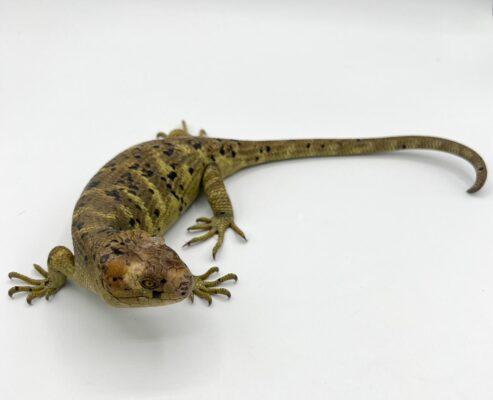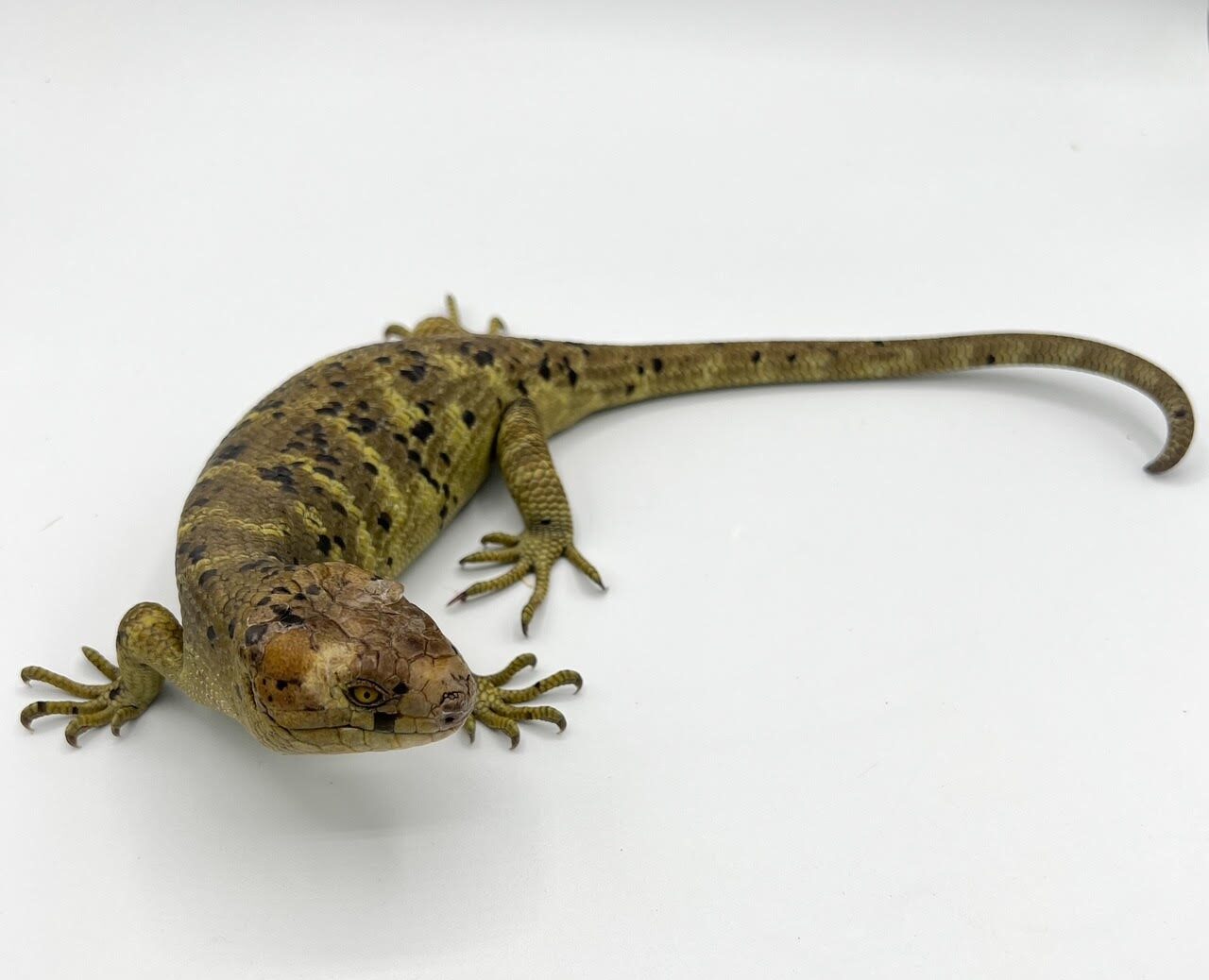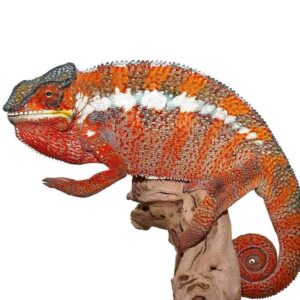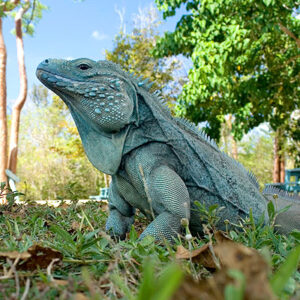C.B. Baby Monkey tail Skink For Sale
$899.99
WE HAVE A BABY MONKEY TAIL SKINK FOR SALE. HERE ARE SOME HIGHLIGHTS:
- Corucia zebrata
- Captive Bred
- Approximately 10 – 14 Inches In Length From Head To Tail
- Adults Can Reach Up To Lengths Of 32 Inches In Total
- These Are Voracious Foragers Feeding On Fresh Fruits And Vegetables
FUN FACTS!
- These Skinks Have Prehensile Tails Meaning They Can Grip And Grab Things With Their Tales
- Gorgeous Animals Not Frequently Seen Here At Underground Covered In Rich Green And Brown Patterns Giving Them Perfect Camouflage
- Naturally Occurring Out Of The Solomon Islands
- These Skinks Have Prehensile Tails Meaning They Can Grip And Grab Things With Their Tales
- Females Are Viviparous Meaning That They Bear Live Young
- With Proper Care These Can Live More Than 20 Years In Captivity
Description
The monkey tail skink, scientifically known as Corucia zebrata, is a remarkable reptile species indigenous to the Solomon Islands. Distinguished by its unique prehensile tail, this skink adeptly utilizes its tail for climbing and maintaining balance, making it a fascinating subject for both researchers and reptile enthusiasts. The monkey tail skink’s tail is not just an appendage but an essential tool for navigating the dense foliage of its arboreal habitat, showcasing an incredible adaptation to its environment.
Physically, monkey tail skinks are notable for their robust, muscular bodies covered in rough, overlapping scales that provide protection and aid in thermoregulation. They typically exhibit a range of colorations from various shades of green to brown, often with lighter or darker blotches that provide effective camouflage among the leaves and branches. Adult skinks can reach lengths of up to 32 inches, including their tail, making them one of the larger species within the skink family.
Behaviorally, monkey tail skinks are primarily nocturnal, spending their nights foraging for food and their days resting in tree hollows or dense foliage. Their diet in the wild is predominantly herbivorous, consisting of leaves, flowers, and fruits, though they occasionally consume insects. This dietary preference makes them relatively easy to care for in captivity, further enhancing their popularity among reptile hobbyists. They exhibit social behavior unusual for reptiles, often living in small family groups, which adds to their intrigue and appeal.
Despite their growing popularity in the pet trade, monkey tail skinks face threats in the wild, primarily due to habitat destruction and illegal collection. Conservation efforts are crucial to ensure the survival of this extraordinary species in its natural habitat. Understanding and appreciating the unique characteristics of the monkey tail skink can foster greater interest in their conservation and the preservation of their natural ecosystems.
Habitat and Natural Environment
Monkey tail skinks, scientifically known as Corucia zebrata, are primarily found in the tropical rainforests of the Solomon Islands. These lush, verdant landscapes provide an ideal habitat for these unique reptiles, offering the optimal combination of climate, vegetation, and altitude. The Solomon Islands, located in the southwestern Pacific Ocean, are characterized by a warm, humid climate with significant rainfall throughout the year, creating the perfect conditions for the dense, leafy canopies that monkey tail skinks favor.
The dense vegetation of these rainforests is teeming with life and provides monkey tail skinks with ample opportunities for shelter and food. These arboreal creatures prefer the upper layers of the forest, where they can navigate through the intricate network of branches and leaves. The thick foliage not only offers protection from predators but also serves as a rich source of their primarily herbivorous diet, which consists of leaves, fruits, and flowers. Their prehensile tails, a distinctive feature, aid in their movement and balance, allowing them to adeptly grasp branches as they forage.
The altitude preferences of monkey tail skinks are generally limited to lower to mid-elevation forests, where the temperature and humidity levels remain relatively stable. These conditions are critical for their physiological and behavioral needs. The natural environment of the Solomon Islands, with its unspoiled and diverse ecosystem, supports the survival and well-being of monkey tail skinks, enabling them to utilize their surroundings effectively for various aspects of their life cycle.
However, the natural habitat of monkey tail skinks is under threat due to deforestation and habitat destruction, driven by logging, agriculture, and human settlement expansion. Conservation efforts are crucial to preserve these tropical rainforests and protect the delicate balance of this ecosystem. By safeguarding their natural habitat, we can ensure the continued existence of monkey tail skinks in the wild, allowing future generations to marvel at these fascinating creatures.
Physical Characteristics and Adaptations
Monkey tail skinks, scientifically known as Corucia zebrata, exhibit a range of unique physical traits that set them apart from other skink species. One of the most distinctive features of these fascinating reptiles is their prehensile tail, which is adept at grasping and holding onto branches, providing them with exceptional stability and maneuverability in their arboreal habitats. This adaptation is a significant evolutionary advantage, allowing them to navigate through trees with ease.
In addition to their remarkable tails, monkey tail skinks possess strong, muscular limbs that aid in climbing and gripping surfaces. Their toes are equipped with sharp claws, further enhancing their climbing abilities. The skinks’ rough, scaly skin provides protection against predators and environmental hazards, while also reducing water loss, a crucial adaptation for survival in their natural environments.
Coloration plays a vital role in the monkey tail skinks’ ability to blend into their surroundings. They typically exhibit shades of green, brown, and grey, which help them camouflage among the foliage and bark of trees. This cryptic coloration is an effective defense mechanism against predators, allowing them to remain undetected while they forage for food or rest.
Monkey tail skinks are relatively large compared to other skink species, with adults reaching lengths of up to 32 inches, including their tail. Their size and robust build contribute to their physical prowess, making them formidable climbers. The lifespan of a monkey tail skink can extend up to 25 years in captivity, although their longevity in the wild is influenced by various environmental factors and predation pressures.
Comparatively, other skink species may not possess the same level of climbing proficiency or prehensile tails, highlighting the unique adaptations of monkey tail skinks. These physical characteristics are integral to their survival, enabling them to thrive in their specific ecological niches. Through these adaptations, monkey tail skinks exemplify the diversity and specialization found within the skink family, showcasing the intricate balance of form and function in the natural world.
Diet and Feeding Habits
Monkey tail skinks, also known scientifically as Corucia zebrata, have a diet that is predominantly herbivorous, mainly consuming various types of leaves, fruits, and flowers. In their natural habitat, these skinks forage for food by climbing trees and shrubs to reach their preferred diet. They are particularly fond of tender leaves and soft fruits, which provide them with essential nutrients required for their health and well-being. Their diet in the wild is diverse, allowing them to obtain a balance of vitamins and minerals critical for their survival.
In the ecosystem, monkey tail skinks play a vital role as herbivores. By consuming a wide range of plant materials, they help in the process of seed dispersal and contribute to the growth of vegetation. This, in turn, supports other wildlife and maintains the ecological balance. Their feeding habits also influence their behavior; for instance, they tend to be more active during the early morning and late afternoon when they forage, avoiding the heat of midday.
For those interested in keeping monkey tail skinks as pets, it is crucial to replicate their natural diet as closely as possible. Offering a variety of leafy greens, such as collard greens, dandelion greens, and romaine lettuce, can help mimic their natural foraging diet. Additionally, providing fruits like bananas, mangoes, and berries can supply the necessary sugars and vitamins. It is important to avoid feeding them high-oxalate foods, such as spinach and beet greens, which can interfere with calcium absorption and lead to health issues.
Proper diet and nutrition are paramount for the health of monkey tail skinks. A balanced diet ensures they receive the essential nutrients required to maintain their vibrant health and active behavior. Providing a variety of fresh, organic plant materials, along with occasional calcium and vitamin supplements, will help keep these fascinating reptiles thriving in captivity. Always ensure that the food is pesticide-free and thoroughly washed to prevent any potential health risks.
Behavior and Social Structure
Monkey tail skinks, also known as Solomon Islands skinks, exhibit intriguing social behaviors and interactions. Primarily arboreal and slow-moving, these skinks are known for their docile nature. They are typically found living in small family groups, often comprising a mating pair and their offspring. This family-oriented structure is essential for their survival, as it provides a support system for nurturing and protecting the young.
Communication among monkey tail skinks is multifaceted, involving a combination of vocalizations and body language. While generally not very vocal, these skinks will emit soft chirps and clicks as a form of communication, especially during mating or when feeling threatened. Body language plays a significant role in their interactions, with tail curling and head bobbing being common behaviors that convey various messages within the group.
Breeding habits of monkey tail skinks are particularly noteworthy. These skinks are ovoviviparous, meaning the females give birth to live young rather than laying eggs. The gestation period lasts approximately seven to eight months, culminating in the birth of one or two fully-formed juveniles. Post-birth, parental care is pronounced, with both parents involved in the upbringing and protection of their young. This extended parental care is crucial for the survival of the offspring, ensuring they receive adequate nourishment and protection during their vulnerable early stages of life.
The development of offspring in monkey tail skinks is a gradual process. Juveniles remain with their family group for an extended period, learning essential survival skills and social behaviors from their parents and older siblings. This prolonged period of social learning helps ensure that the young skinks are well-prepared for independent life in their natural habitat.
In summary, the behavior and social structure of monkey tail skinks are complex and fascinating. Their docile nature, intricate communication methods, and strong family bonds highlight the unique adaptations that have enabled these skinks to thrive in their environments.
Housing and Care in Captivity
Creating an appropriate habitat for monkey tail skinks in captivity necessitates a well-thought-out enclosure that mimics their natural environment. The enclosure size should be spacious enough to allow for both ground and arboreal activities, with a minimum dimension of 4 feet by 2 feet by 4 feet recommended for a single adult skink. This space should be adequately ventilated and escape-proof to ensure the safety and well-being of the skinks.
Maintaining the right temperature and humidity levels is crucial for the health of monkey tail skinks. The ambient temperature within the enclosure should range between 75°F to 85°F, with a basking spot that reaches up to 95°F. A temperature gradient is essential to allow the skinks to regulate their body temperature effectively. Humidity levels should be kept between 60% to 80%, replicating their native tropical forest environment. Using a hygrometer to monitor humidity and a misting system or regular misting can help achieve these conditions.
Proper lighting is another critical aspect of monkey tail skink care. UVB lighting is necessary to facilitate the synthesis of vitamin D3, which is vital for calcium metabolism and overall health. A 10-12 hour light cycle can simulate natural daylight and help maintain a consistent environment. Full-spectrum lights that provide both UVA and UVB rays are ideal for these skinks.
Enrichment within the enclosure is essential for the mental and physical well-being of monkey tail skinks. Incorporating climbing structures, such as branches and vines, and providing hiding spots with cork bark or commercial hides can create a stimulating and secure environment. Live or artificial plants can also enhance the habitat, offering additional shelter and climbing opportunities.
Proper care and maintenance are pivotal in preventing common health issues in monkey tail skinks. Regular cleaning of the enclosure, monitoring for signs of parasites, and ensuring a balanced diet rich in leafy greens, fruits, and occasional protein sources can mitigate health problems. Hydration is also crucial, and providing a shallow water dish for drinking and soaking can help maintain hydration levels.
Conservation Status and Threats
Monkey tail skinks, scientifically known as Corucia zebrata, are currently facing significant challenges in the wild. Listed under Appendix II of the Convention on International Trade in Endangered Species (CITES), these unique reptiles are vulnerable primarily due to habitat destruction, illegal pet trade, and climate change.
Deforestation and habitat fragmentation are among the foremost threats to monkey tail skinks. The tropical rainforests of the Solomon Islands, their native habitat, are being cleared at alarming rates for logging and agricultural expansion. This destruction not only reduces the available living space for these skinks but also disrupts their ecological niche, making it harder for them to find food and reproduce.
Another pressing issue is the illegal pet trade. Monkey tail skinks are often captured and sold due to their distinctive appearance and relatively docile nature. This trade not only depletes wild populations but also subjects these skinks to stressful and often deadly conditions during transport and captivity. Despite regulations, the enforcement of wildlife trade laws remains a challenge.
Climate change further exacerbates the threats to monkey tail skinks. Rising temperatures, altered precipitation patterns, and increased frequency of extreme weather events are impacting their natural habitats. These changes can lead to shifts in vegetation and microclimates, making it difficult for skinks to adapt and survive.
Various conservation efforts are in place to protect monkey tail skinks. Organizations such as the International Union for Conservation of Nature (IUCN) and local NGOs are working to preserve their habitats through sustainable land management and reforestation projects. Educational programs aimed at raising awareness about the plight of monkey tail skinks are also crucial, as they can reduce demand in the illegal pet trade.
Individuals can contribute to the conservation of monkey tail skinks by supporting these organizations through donations or volunteer work. Advocating for stronger wildlife protection laws and responsible consumer behavior can also make a significant difference. Educating oneself and others about the importance of biodiversity and the specific challenges faced by monkey tail skinks can help foster a culture of conservation.
Fun Facts and Myths
Monkey tail skinks, also known as Solomon Islands skinks, are captivating creatures with some intriguing and, at times, surprising characteristics. One of the most fascinating aspects of these reptiles is their prehensile tails which they use much like monkeys to grasp branches and navigate their arboreal environment. This unique adaptation not only aids in their survival but also underscores their name.
These skinks are known for their social behavior, which is quite rare among reptiles. They often live in family groups where both parents participate in the upbringing of their offspring. Such communal living and parental care are behaviors more commonly associated with birds and mammals rather than reptiles. It’s a testament to their complex social structures and advanced survival strategies.
Historically, monkey tail skinks have held a special place in the folklore of the Solomon Islands. Locals have long shared tales of these reptiles, often attributing mystical qualities to them. One popular myth suggests that these skinks possess the ability to bring good luck and protect homes from evil spirits. As a result, they are sometimes considered guardians of the forest and are treated with great respect.
Another lesser-known fact about monkey tail skinks is their herbivorous diet. Unlike many reptiles that are carnivorous, these skinks primarily feed on leaves, flowers, and fruits. This plant-based diet is not only rare among reptiles but also reflects their unique ecological niche within the rainforest ecosystem.
In addition to their dietary habits, monkey tail skinks exhibit a fascinating form of camouflage. Their green and brown coloration allows them to blend seamlessly into the foliage of their habitat, making them nearly invisible to predators. This natural camouflage is a vital adaptation that enhances their survival in the wild.
Overall, the monkey tail skink is a remarkable species whose unique behaviors, historical significance, and cultural myths contribute to its allure. Understanding these aspects can deepen our appreciation for these reptiles and highlight the importance of their conservation.






